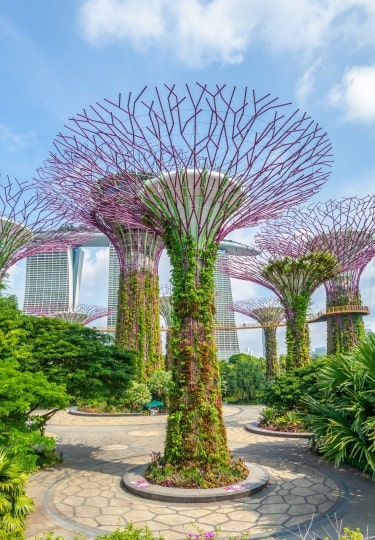Ultra-sophisticated Singapore is the only place in the world that is a city, a state, and an island. Its diversity of cultures—Malay, Chinese, Indian and European—make Singapore richly varied in its heritage, cuisines, art, and architecture.
Thanks to a remarkable greening program that began in the 1960s, the city is known as Southeast Asia’s “City in a Garden”. Many skyscrapers are adorned with vertical gardens, and Singapore is home to an incredible number of parks and green spaces for its size.
Here are 12 of the most famous landmarks in Singapore to see when you next visit this vibrant tropical country.
Gardens by the Bay
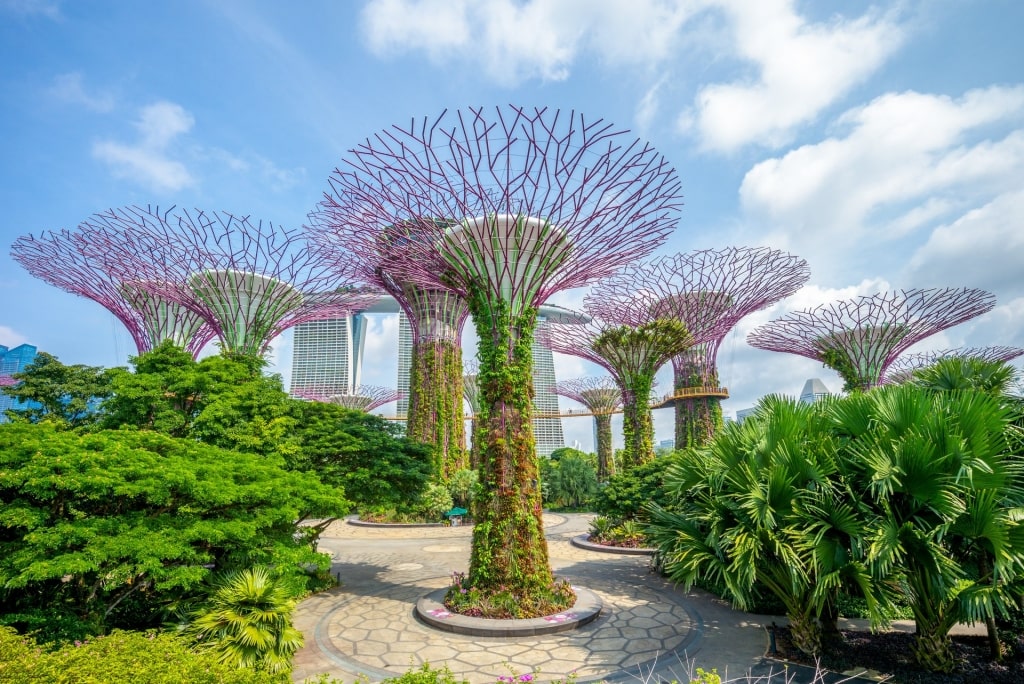
Gardens by the Bay
Three huge, contemporary glass structures house more than a million plants from around the world at Gardens by the Bay, a horticultural and architectural wonder that covers about 250 acres of Singapore’s Marina Bay waterfront.
The first one, the Flower Dome, is the largest cooled glass conservatory in the world and showcases a breath-taking array of plants and flowers from five continents in nine different gardens. Themed exhibitions such as the annual Tulipmania attract thousands of visitors and floral displays change seasonally.
Floral Fantasy, the second conservatory, is divided into four zones—Dance, Float, Waltz, and Drift—that feature garden artistry taken to a whole new level. Displays are inspired by fairy tales and the legendary Hanging Gardens of Babylon, one of the seven ancient Wonders of the World.
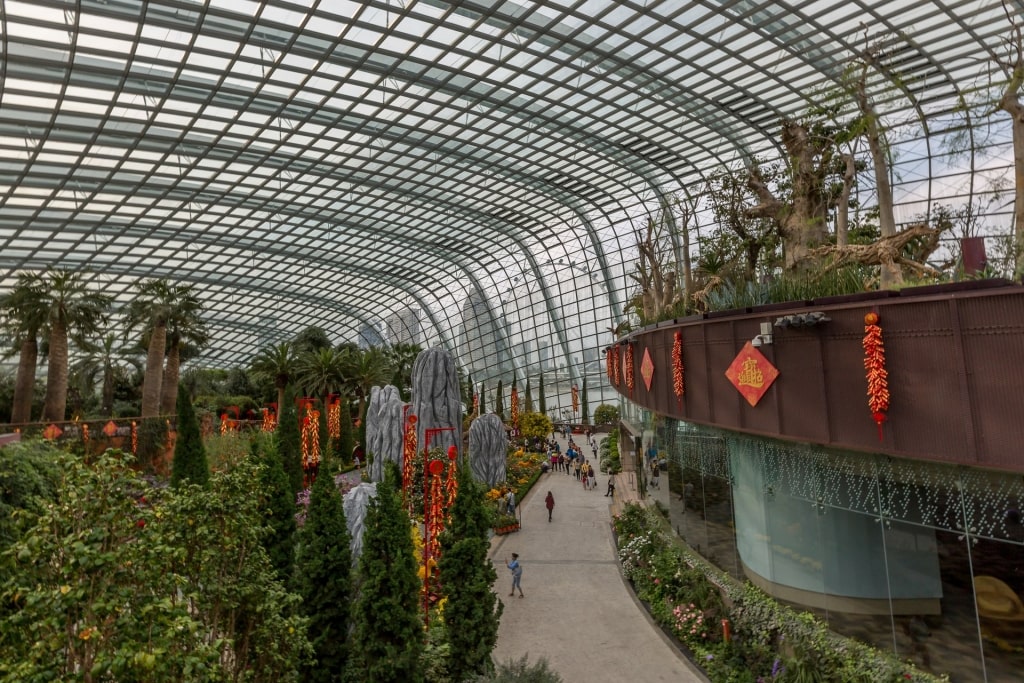
Cloud Forest, Gardens by the Bay
Cloud Forest, the third conservatory, is dominated by the 115-foot tall, jungle-clad Cloud Mountain and the world’s tallest indoor waterfall. You can walk along the misty Cloud Walk and Tree Top Walk for a closer inspection of cloud forest vegetation and great views of the Marina Bay waterfront.
One of the most beautiful places in Asia, The Gardens is home to 18 iconic Supertrees—an instantly recognizable landmark in Singapore. Varying in height from 82 to 164 feet, two are connected by the OCBC Skyway, a 420-foot aerial walkway. At night, the Supertrees are transformed into a spectacular light and sound show.
Read: Three Days in Singapore
Merlion Park
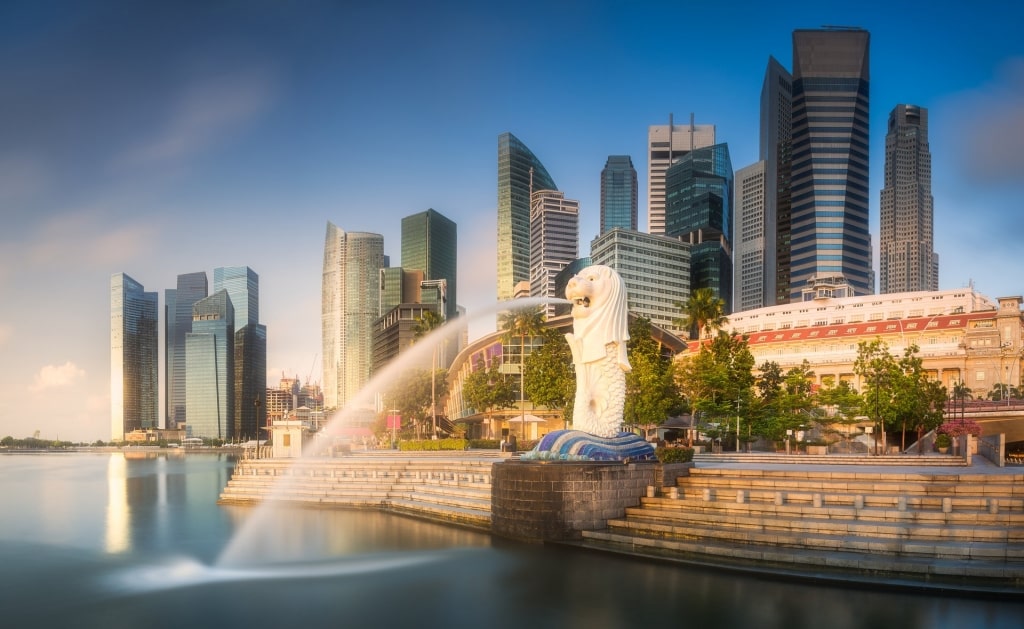
Merlion Park
The striking Merlion sculpture on the Merlion Park waterfront is one of Singapore’s most famous landmarks. Its lion’s head represents Singapore’s original name (Singapura) which means “lion city”, while its fish tail symbolizes the country’s early history as a fishing village.
Visitors throng Merlion Park waterfront for photo opportunities with the mighty Merlion—and its smaller “cub”—and for panoramic views of Marina Bay and one of the best skylines in the world. It’s a great spot to visit at sunset, when the massive, three-tower Marina Bay Sands, Singapore Flyer, and ArtScience building, which resembles a lotus flower, light up.
You can walk around the waterfront to Marina Bay Sands in about half an hour or join a 40-minute bumboat cruise along the Singapore River at the Merlion Park jetty.
Singapore Botanic Gardens
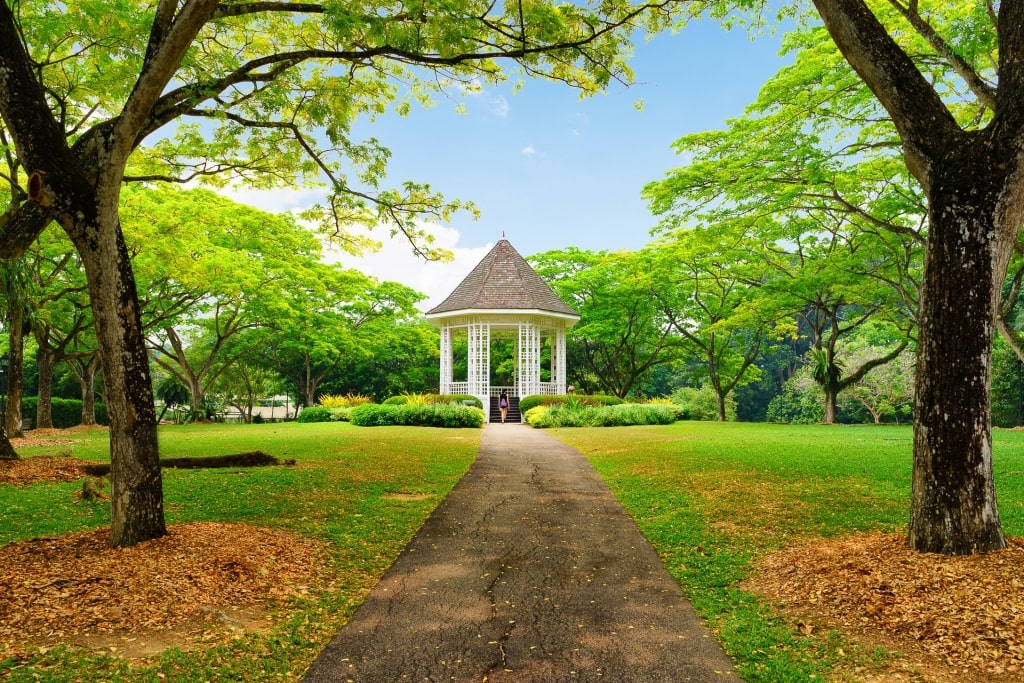
Singapore Botanic Gardens
Sixty acres of former plantation land were established as the Singapore Botanic Gardens in 1859 and in 2015, the gardens became the country’s first UNESCO World Heritage Site. As the only tropical botanic garden on the World Heritage list, this is one of Singapore’s famous landmarks.
Today, the garden is a peaceful green retreat just steps away from busy Orchard Road, where you can stroll around four distinct “Core” areas and explore the Gardens’ illustrious history at the SBG Heritage Museum.
The four Cores house thousands of plant varieties, including rare orchids and ancient trees, as well as waterfalls, lakes, fountains, a “learning forest”, and the imaginatively designed Jacob Ballas Children’s Garden.
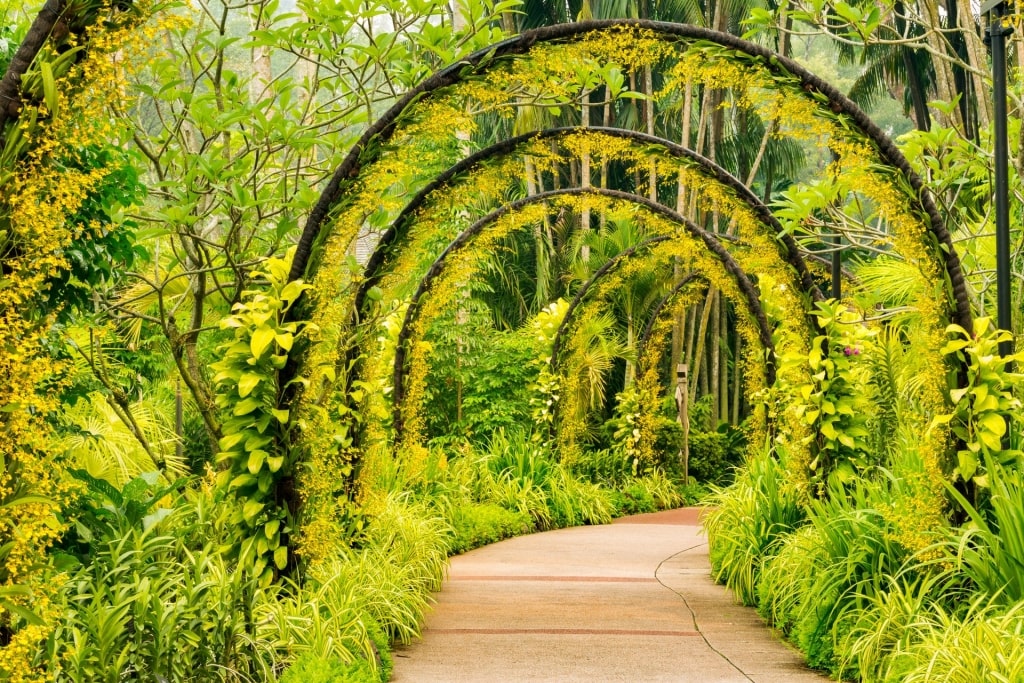
National Orchid Garden
Each Core has its own theme and there are five entrances to the Gardens—Tanglin, Tyersall, Gallop, Nassim, and Bukit Timah. If your time is limited, the National Orchid Garden, near the Tyersall gate, is a must-see; more than 1,000 orchid species and 2,000 hybrids are displayed in a series of cool houses and an orchidarium.
There are several good eateries and cafés in the SBG and attractive shops where you’ll find the perfect gift for the gardening enthusiasts in your life.
Marina Bay Sands
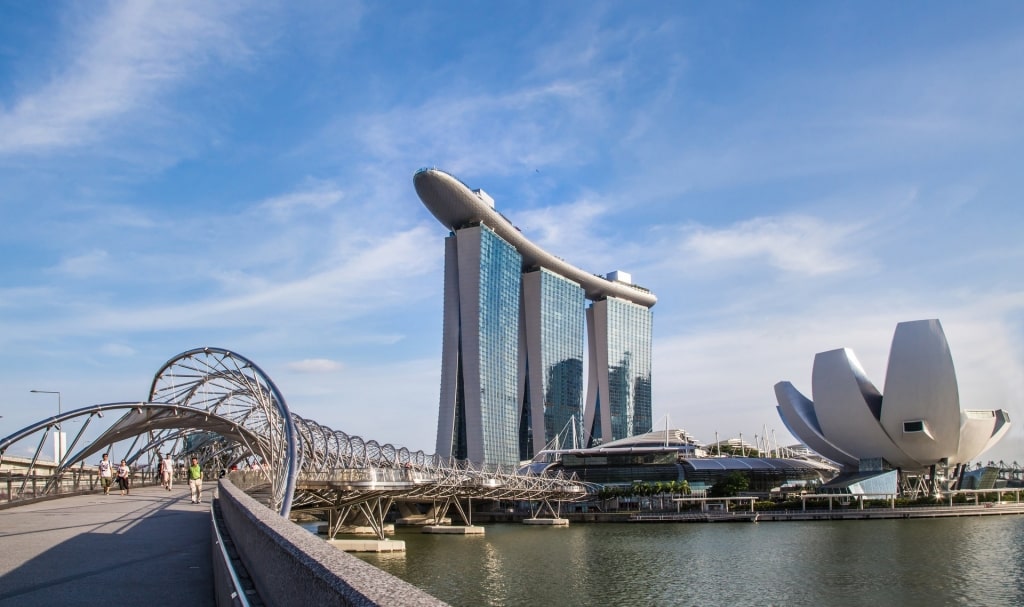
Marina Bay Sands
This three-pronged, 55-story-high Singapore landmark combines ultra-luxury hotel accommodation, numerous designer shops, dozens of upscale restaurants and bars, a casino, theater, nightclub, and the cutting-edge on-site ArtScience Museum.
Sands SkyPark straddles the top of three towers and the Observation Deck on the 57th floor is open to visitors. The 360-degree views are well worth the entry charge, particularly at night, but the fabulous infinity pool is for hotel guests only.
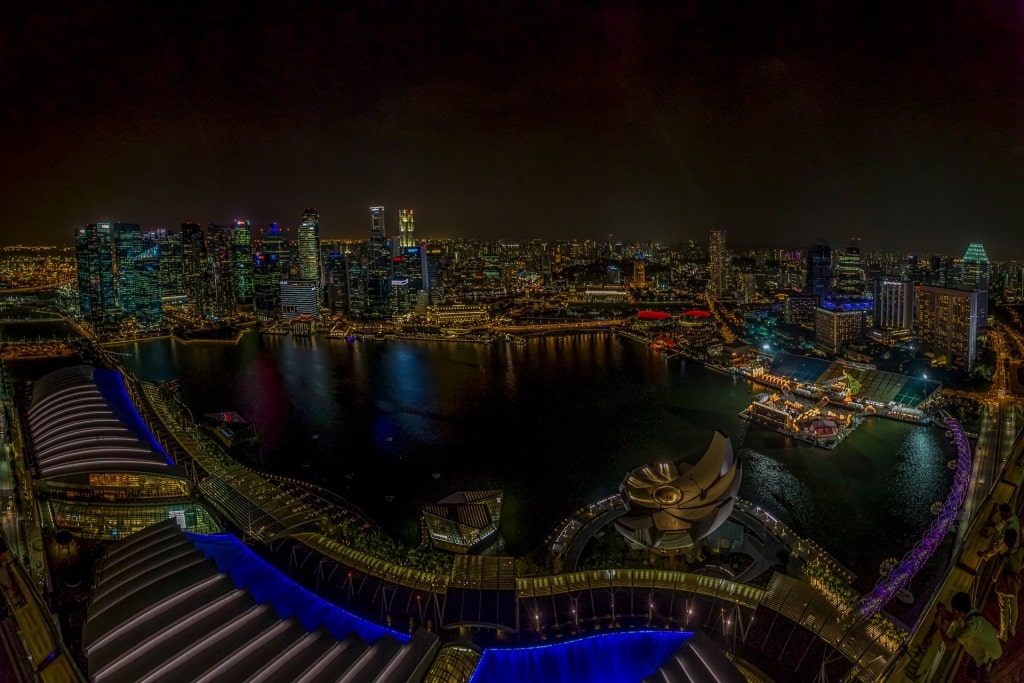
Sands SkyPark
Fine dining and cocktails with a view don’t come much better than at Sands SkyPark, where you’ll find an extraordinary array of restaurants by celebrity chefs. Choose from Spago Dining Room by Wolfgang Puck, Spago Bar and Lounge, Lavo Italian Restaurant and Rooftop Bar, Cé La Vi Club Lounge, or Cé La Vi Restaurant and Skybar for a truly memorable night out.
As well as Wolfgang Puck’s establishments, Marina Bay Sands is famous for four more culinary legends: db Bistro & Oyster Bar by Daniel Boulud, Bread Street Kitchen by Gordon Ramsay, Chinoiserie and JustIN by Justin Quek, and Waku Ghin by Tetsuya Wakuda.
ArtScience Museum
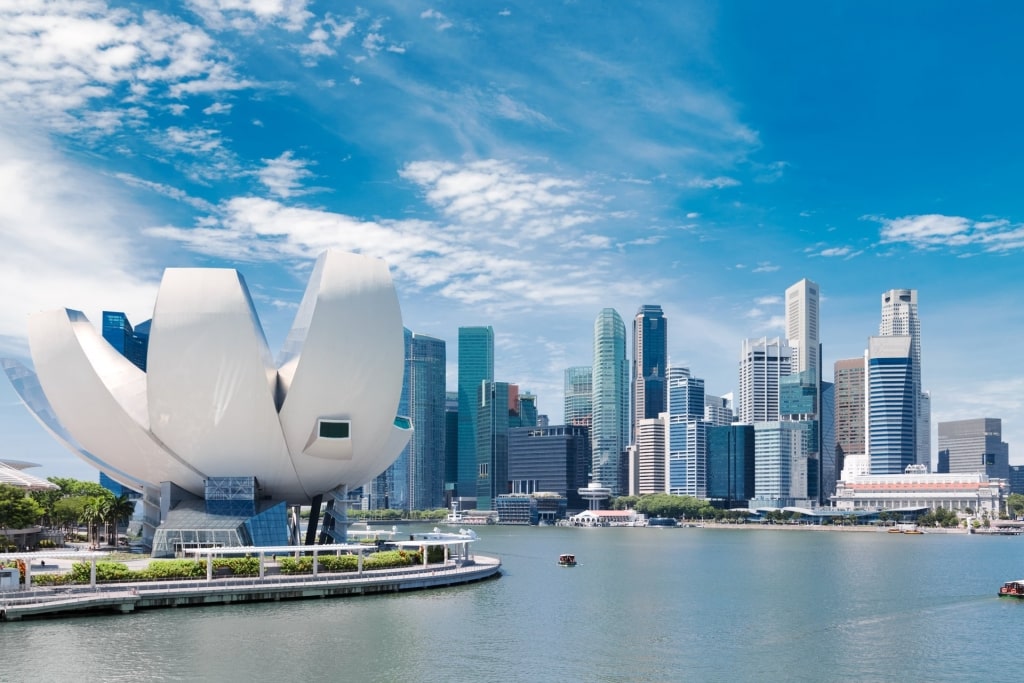
ArtScience Museum
The lotus-inspired ArtScience Museum opened in 2011 and has become one of Singapore’s best-known cultural landmarks. Designed by world-renowned architect Moshe Safdie, it opened in 2011 and has hosted exhibitions by some of the biggest names in the art world—Salvador Dali, Leonardo da Vinci, Vincent Van Gogh and Andy Warhol, just to name a few—as well as ground-breaking science, technology and digital exhibits.
Covering nearly 65,000 square feet in the Marina Bay area and reaching up to 197 feet high, this distinctive building has 10 “fingers” that are anchored in a round, central base. Each finger houses a different gallery space or hall.
Exhibitions change regularly, as you’d expect in such a cutting-edge institution, but “Future World: Where Art Meets Science” is permanent—although constantly updated. Visiting here is one of the best things to do in Singapore with kids, as it features 19 digital artworks from the award-winning Japanese collective teamLab that bring art, science, and “magic” together in four incredible shows themed around City in a Garden, Sanctuary, Park, and Space.
National Museum of Singapore
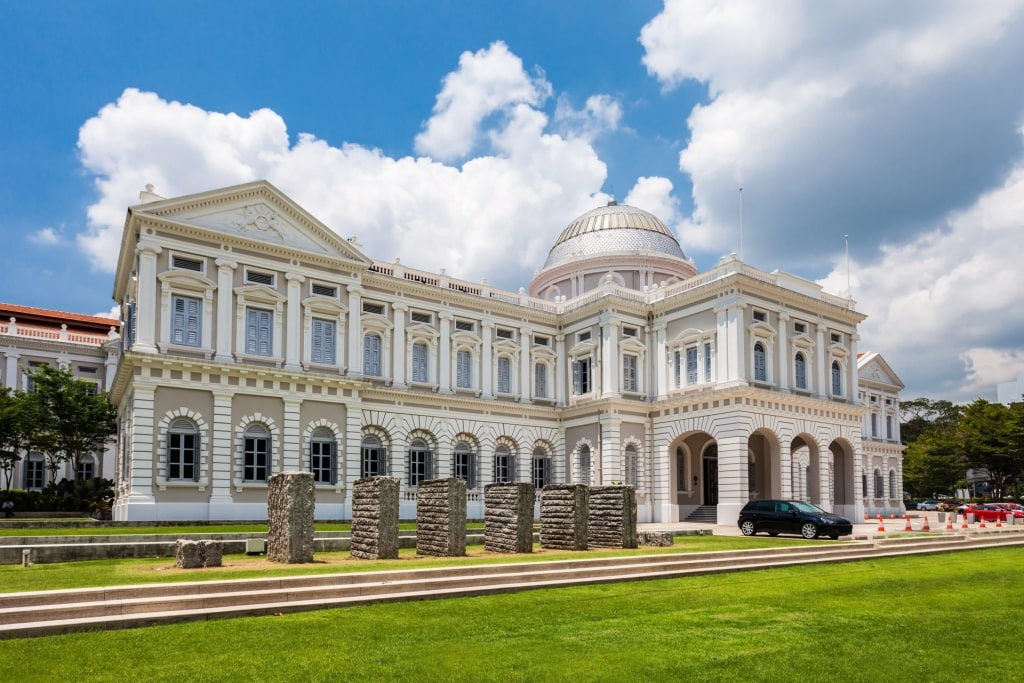
National Museum of Singapore
You don’t have to be a history buff to enjoy the magnificent National Museum of Singapore, one of Singapore’s famous historic landmarks. Although it is the country’s oldest museum, the grand, 19th-century colonial building uses the latest multimedia technology to tell the story of Singapore from its foundation in the 14th century to the present day.
Although the museum was founded in 1849, when its initial collections were housed in the Raffles Library and Museum, it has been on the Stamford Road site since 1887. The original domed neoclassical building was extended with an elegant glass rotunda and passageway in the early 2000s.
While the museum hosts an inspiring range of events and exhibitions every year, if you’re keen to learn about Singapore’s history you should visit a selection of its 12 permanent exhibitions. These include the fascinating Singapore History Gallery, An Old New World: Digital Edition, and A Voyage of Love and Longing.
Helix Bridge
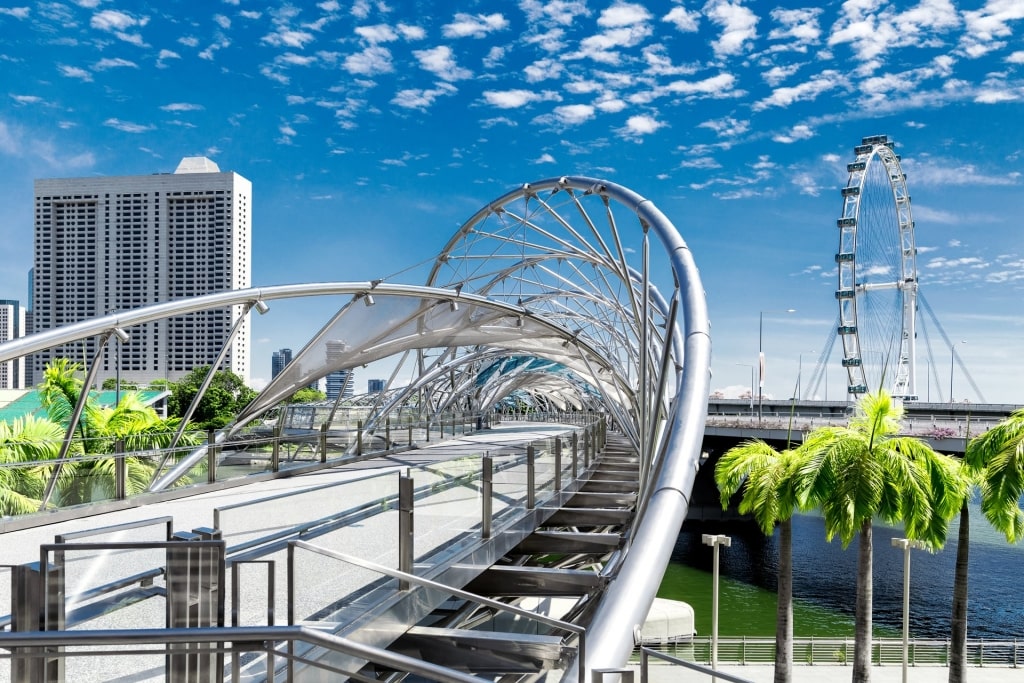
Helix Bridge
Designed and engineered by a team of leading architects from Singapore and Australia, the Helix Bridge is one of Singapore’s most intriguing modern landmarks. Its distinctive double-helix structure is based on the structure of human DNA and is said to symbolize “life and continuity, renewal and growth”. There’s no other structure like it in the world and it took about three years to construct, opening in 2010.
The 920-foot-long bridge spans the Singapore River and links landmark attractions such as the Singapore Flyer and Esplanade Theatre on one side to the Marina Bay Sands and ArtScience Museum on the other. It is about three stories high and, for those who love trivia facts, the double helix is made up of some 7,380 feet of steel tubes.
Intricate glass and steel canopies provide shade during the day and there are five viewing pods along the walkway, cantilevered over the river. At night the bridge is lit up, adding yet another element to Singapore’s spectacular Marina Bay district.
Clarke Quay
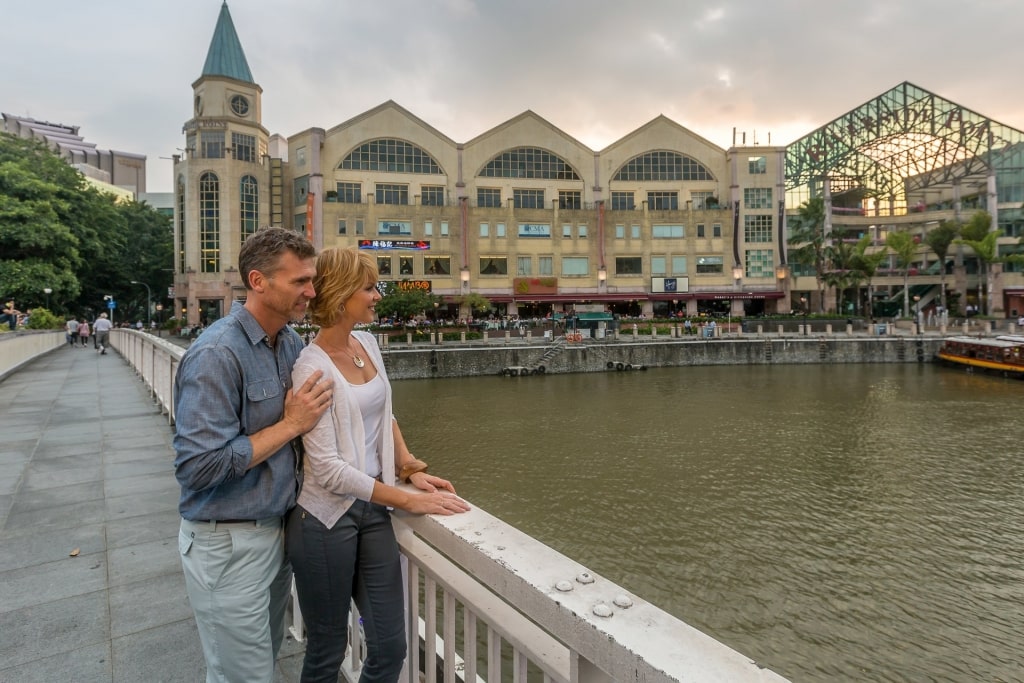
Clarke Quay
Clarke Quay is one of three quays—Clarke, Robertson, and Boat—on the Singapore River that were important trading hubs in the 19th century. Goods were transported from all over Asia and stored in warehouses (“godowns”) lining the quays, which were in constant use until the 1970s.
Because the river had become so polluted, the government relocated cargo services to the Pasir Panjang area and invested millions of dollars in cleaning the waterway and refurbishing the quays.
The once rundown warehouses have been converted to colorful restaurants, pubs, and nightclubs. Old Chinese junks are now floating restaurants and bars, and traditional bumboats offer river cruises and operate as water taxis. The quays offer plenty of photo opportunities and are a reminder of Singapore’s past glories as a maritime trading center.
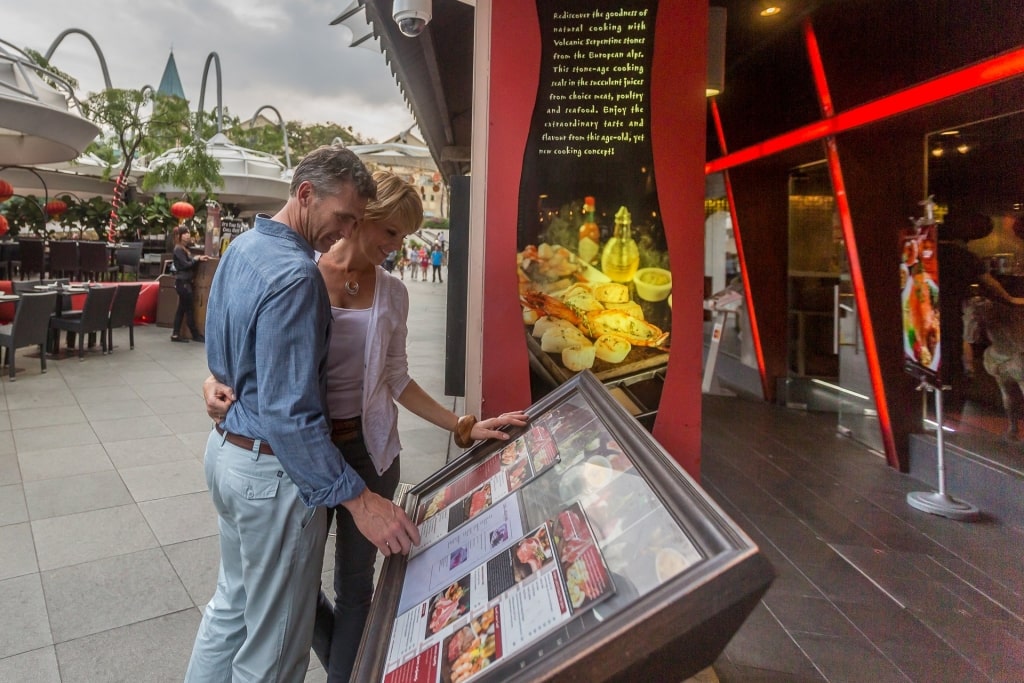
Clarke Quay
Clarke Quay, the busiest of the three quays, is always packed with visitors and locals, particularly at night. If you’re looking for bright lights and lively bars to suit all tastes, this is the go-to precinct. Robertson Quay is a little more laid-back and appeals more to the 30-plus crowd.
Read: What to Buy in Singapore
Lau Pa Sat
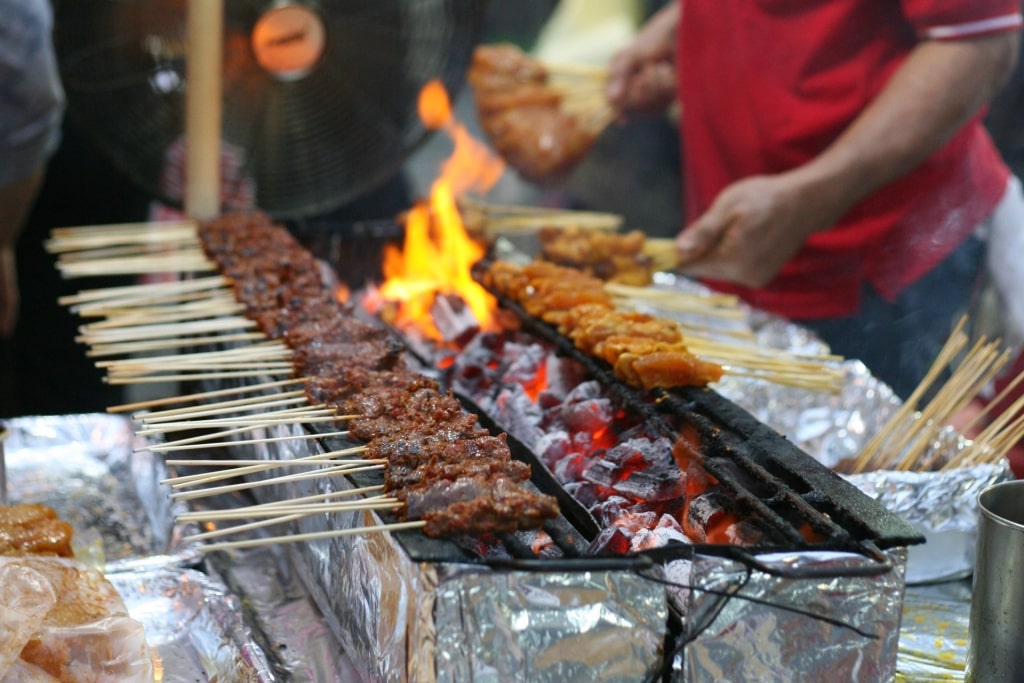
Lau Pa Sat
This buzzing hawker center has been a Singapore landmark since it opened as a fish market in 1894, replacing the original 1820s waterfront market. Over the years it has undergone several makeovers but it remains essentially as it was designed by George Coleman, the architect of many graceful colonial buildings you can see in Singapore today. In 1973, it was given official national monument status.
Lau Pa Sat Festival Market—also known as Telok Ayer—is in the heart of the financial district, surrounded by gleaming skyscrapers. Its amazing array of street food stalls attracts thousands of office workers every lunchtime and evening. The area at the front is transformed into “Satay Street”, an outdoor restaurant, at 7pm sharp.
As well as producing possibly the best satay sticks you’ll ever taste, Lau Pa Sat’s hard-working stallholders serve up a wonderful array of Asian food. Look for your favorite Malaysian, Indonesian, Korean, Vietnamese, Indian, and Filipino dishes.
The Singapore Flyer
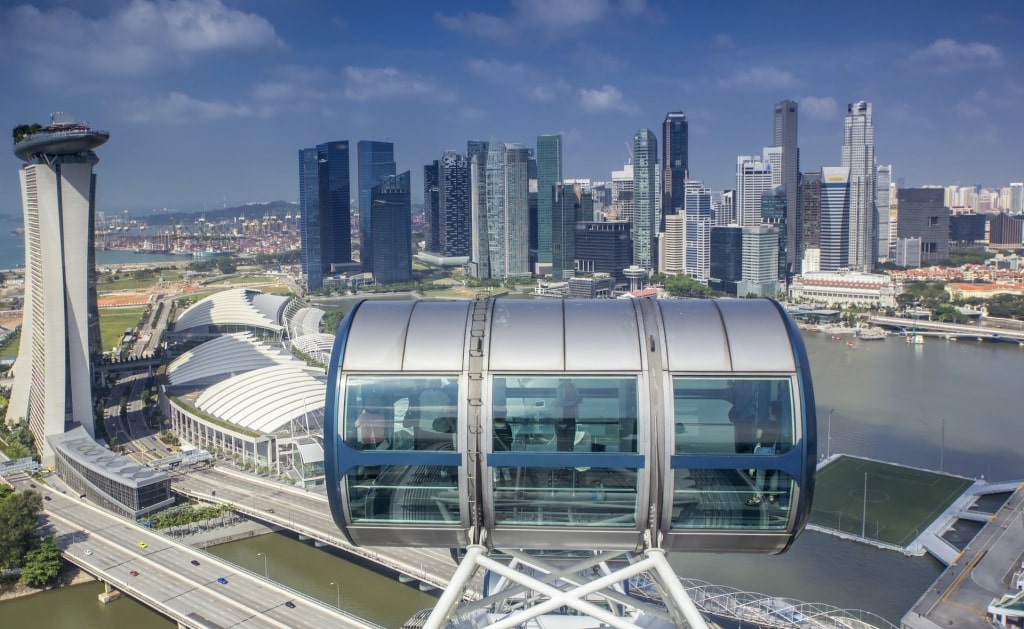
The Singapore Flyer
It seems that every major city has an “observation” or Ferris wheel these days and Singapore is no exception. At 541 feet above the ground, the Singapore Flyer is bigger than most (including the London Eye) and certainly the biggest in Asia.
Located in Marina Bay, the Flyer began operating on February 14, 2008. It has 28 air-conditioned glass capsules that each accommodate 28 passengers and “flights” last 30 minutes. As you’d expect, the views are incredible—you’ll enjoy a bird’s eye view of the entire city and its surroundings, stretching as far afield as Sentosa Island.
Raffles Hotel
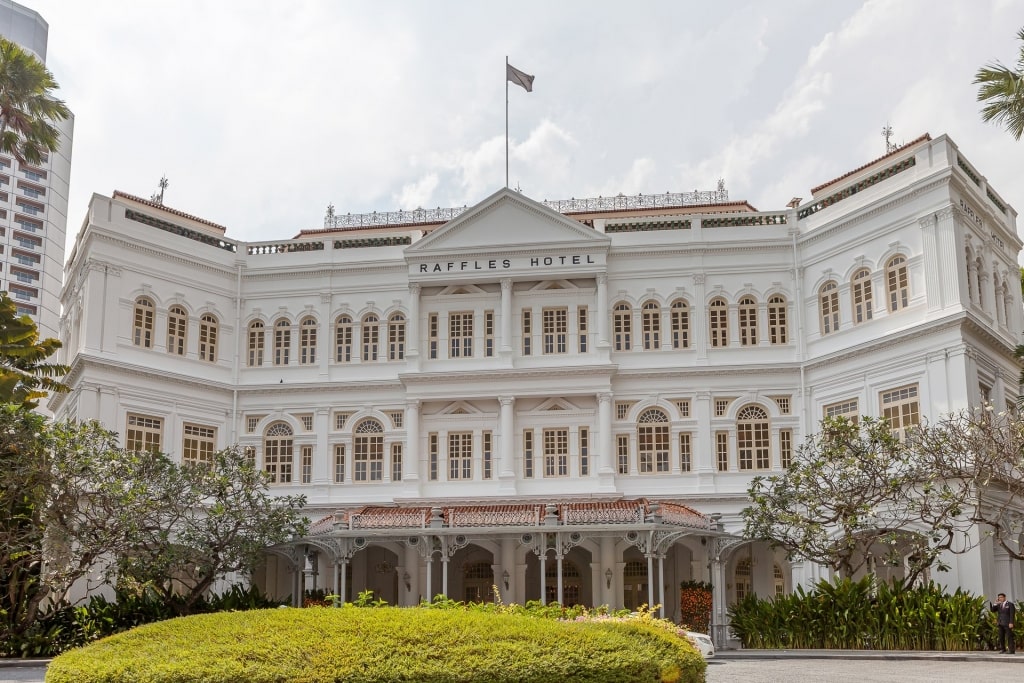
Raffles Hotel
Who hasn’t heard of Raffles Hotel? Arguably the most famous landmark in Singapore, this sublimely elegant hotel has hosted such illustrious guests as Rudyard Kipling, Somerset Maugham, Queen Elizabeth II, Elizabeth Taylor, and Karl Lagerfeld since it opened its doors in 1887.
Raffles is named after the man who founded modern Singapore in 1819, Sir Stamford Raffles. The hotel was built by the Sarkies Brothers (a presidential suite is named after them) and it is one of very few classic 19th-century hotels in the world still operating today.
Raffles underwent major facelifts in 1989 and 2019 to restore it to its original colonial glory, reinstating some features and repairing others. New additions include three prestigious restaurants led by international chefs, and you can still book lunch or dinner at the fabled Tiffin Room for a traditional North Indian feast.
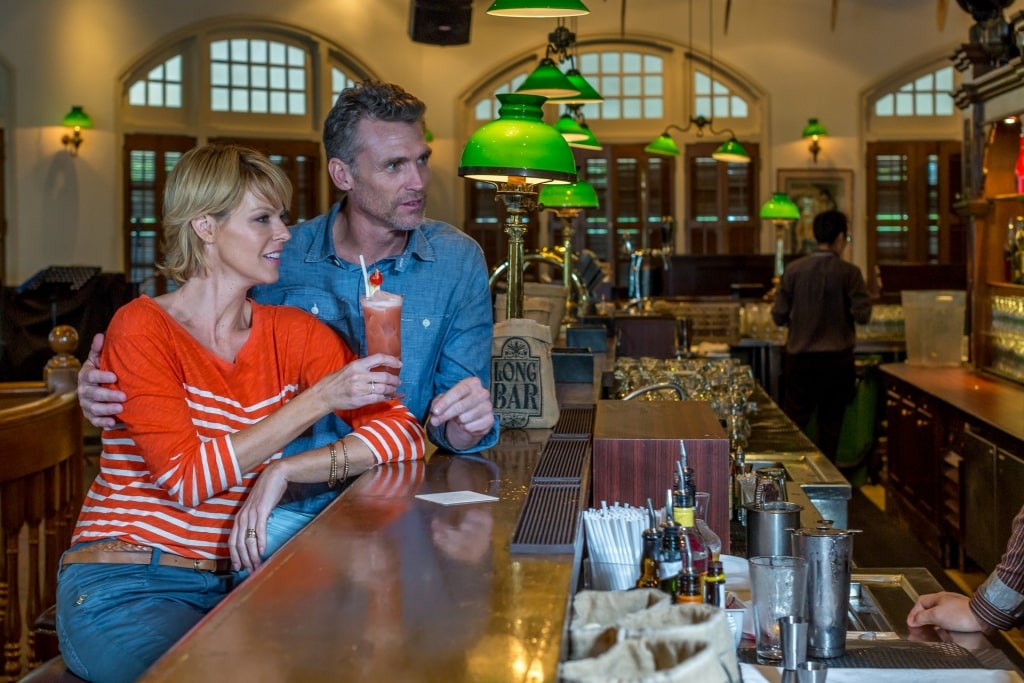
Long Bar, Raffles Hotel
Another long-standing tradition you can indulge in is a Singapore Sling in the Long Bar. The gin-based cocktail has a history all of its own—and guests at the Long Bar are still allowed to throw peanut shells on the floor. You’ll have to go there to find out why.
Esplanade—Theatres on the Bay
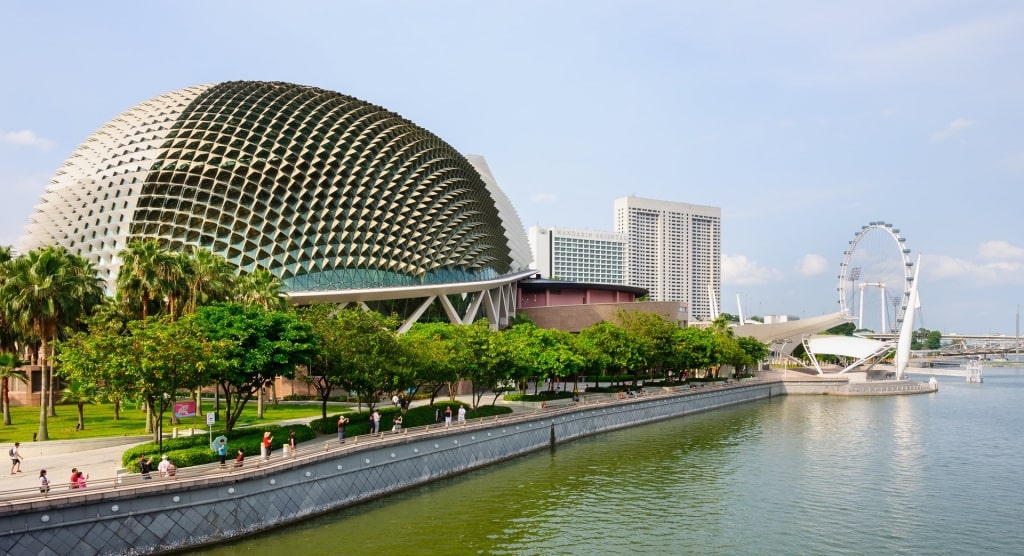
Esplanade
Locals know the spiky, twin-structured Esplanade performing arts center as the “durian” because it so strongly resembles the notoriously smelly tropical fruit in shape. Its revolutionary design caused some controversy when it opened in 2002 but the center is now seen as an integral part of Marina Bay’s contemporary skyline.
Esplanade’s spiky exterior is made up of some 7,000 triangular aluminium sunshades set on two glass domes. Inside, the complex houses a 2,000-seat theater, a 1,600-seat concert hall, a recital studio, a theater studio and visual art exhibition spaces, along with cafés, restaurants, and shops. There is also an outdoor theater, and a new 550-seat venue is due to open in June 2022.
As well as being one of Singapore’s famous architectural landmarks, Esplanade is Singapore’s national performing arts center. The non-profit organisation stages about 3,000 performances a year, comprising an astonishing range of music, visual arts, theater, dance and film.
Read: Best Beaches in Singapore
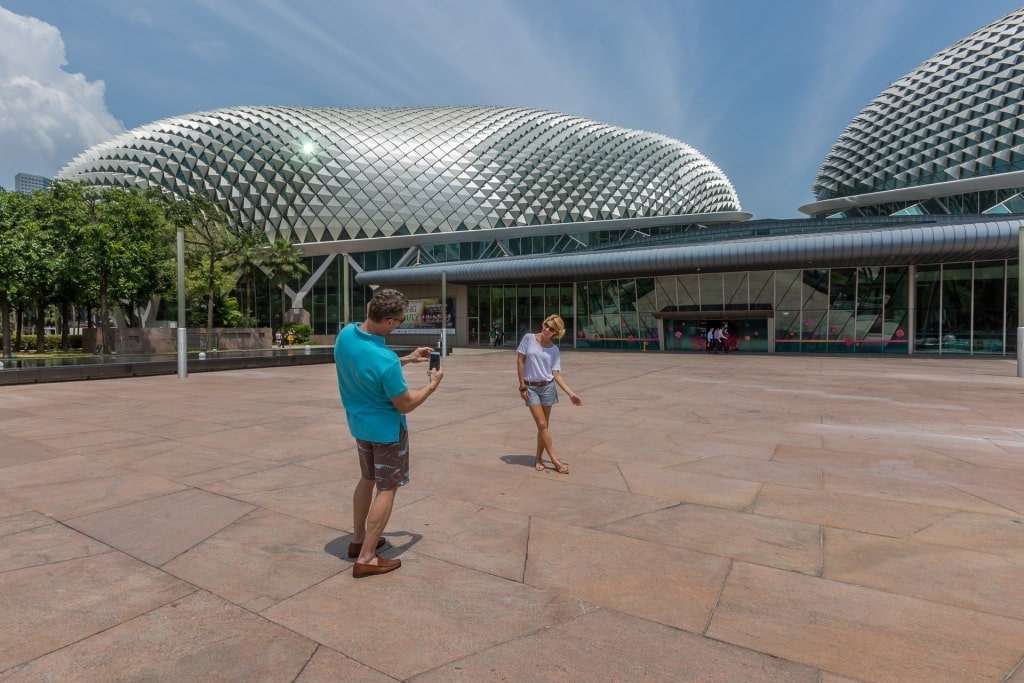
Esplanade
Experience the diverse cultural and historical significance of these famous landmarks in Singapore on a voyage with Celebrity Cruises. Browse our cruises to Southeast Asia and plan an exciting vacation today.
